If you’re anything like me, you know that Hawaiian honey stands out for its quality and unique flavors. You can find Hawaiian honey products from local farms, specialty stores, and online shops.

From raw and organic honey to specialty gift sets, there are options for every taste and need.
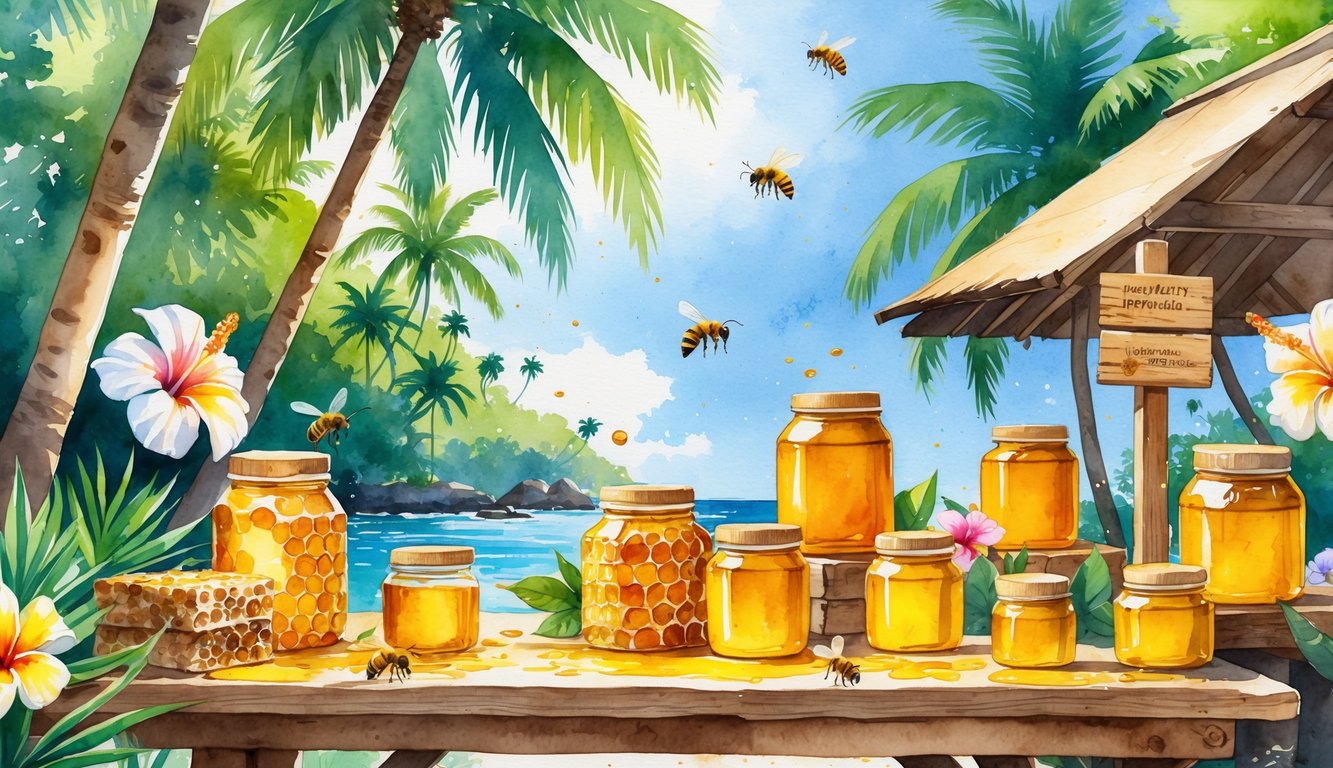
I love exploring brands like Big Island Bees, which offers raw and organic honey straight from their own hives. Hawaiian Rainbow Bees and Mānoa Honey also offer honeycombs, infused honey, and bee pollen.
You can always find local choices, whether you want something for yourself or a sweet gift.
What Makes Hawaiian Honey Unique?
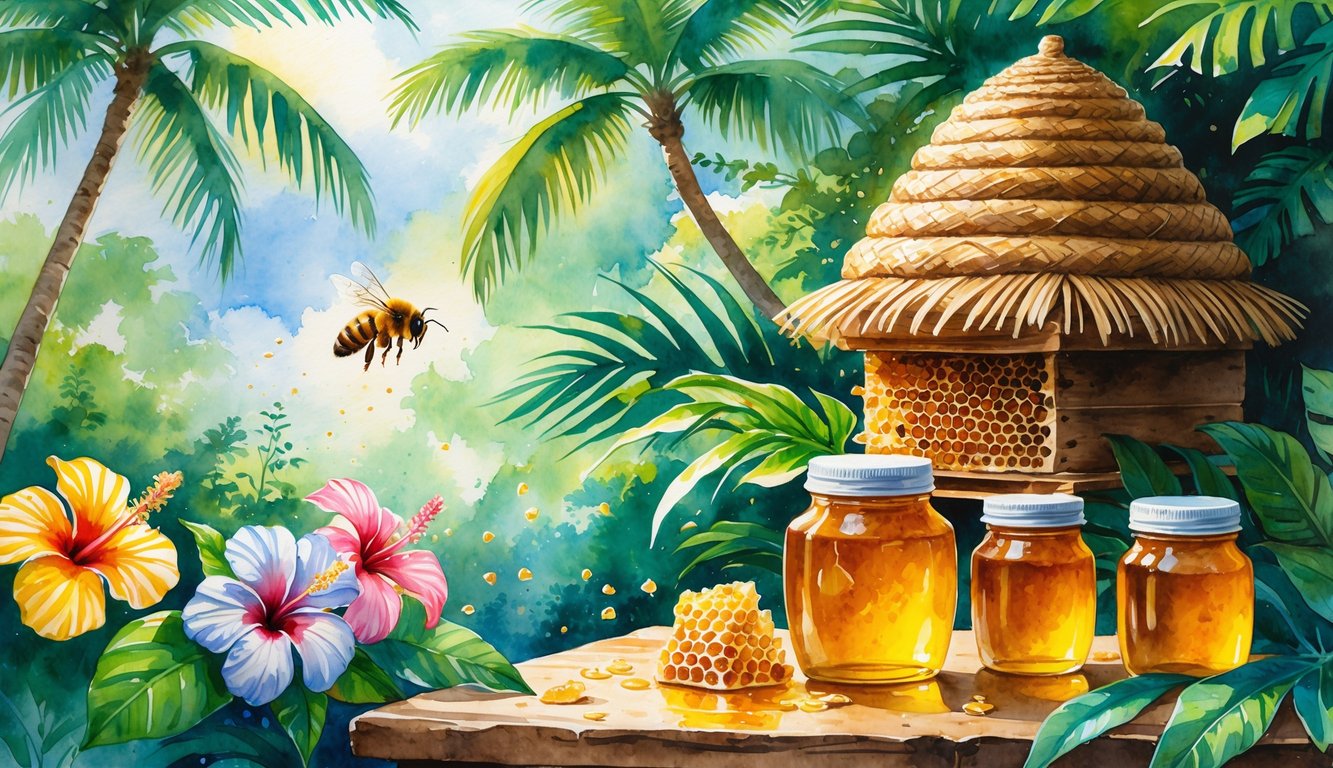
Hawaiian honey has distinct flavors and rare varieties. Local beekeepers and native plants shape each honey’s taste.
The specific flowers that bees visit and Hawaii’s unique environment influence the honey.
Hawaiian Honey Varietals
Hawaii’s bees make several special honey types. Some of the most well-known are Lehua honey, Macadamia honey, Christmas Berry honey, and the rare Kiawe honey.
Each variety comes from a specific plant’s nectar, which gives it unique colors, tastes, and textures. Kiawe honey is rare because Kiawe trees grow in just a few dry places in Hawaii.
Lehua honey comes from the bright red flowers of the native ohia lehua tree in Hawaiian forests.
Most Hawaiian honey is raw and unfiltered, so it keeps more natural flavors and nutrients. These local varieties let you taste the diverse landscapes of the islands. Learn about Hawaiian varietals.
Flavor Profile of Lehua Honey
Lehua honey is probably the most famous Hawaiian honey. It has a creamy, buttery texture that many people love.
When I taste Lehua honey, it feels spreadable and soft, not runny like most store-bought honey. The flavor is mild, with hints of vanilla and a touch of floral sweetness.
It is not overly sugary or strong, so it pairs well with foods like toast, cheese, or even eaten by itself with a spoon. The color is usually a pale, cloudy white, which comes from the ohia lehua flower nectar.
Because the ohia lehua tree only grows in Hawaii, Lehua honey is truly a local treat. Bee colonies depend on healthy natural forests, so this honey is closely tied to Hawaii’s native plants.
Role of Beekeepers in Hawaii
Hawaiian beekeepers care deeply about how they make their honey. Most producers keep their honey raw and unprocessed, using only light filtration to remove wax or debris.
This careful method lets the natural flavor shine through, which is important for single-flower honeys like Lehua and Kiawe. Beekeepers also protect their bees from pests and diseases, since Hawaii’s bees are important for both honey and local food crops.
Many beekeepers work on small family farms and make sure their bees visit certain flowers. Their work keeps the honey pure and local, supporting Hawaiian agriculture and biodiversity. More about Hawaii’s beekeeping.
Where to Buy Hawaiian Honey Locally
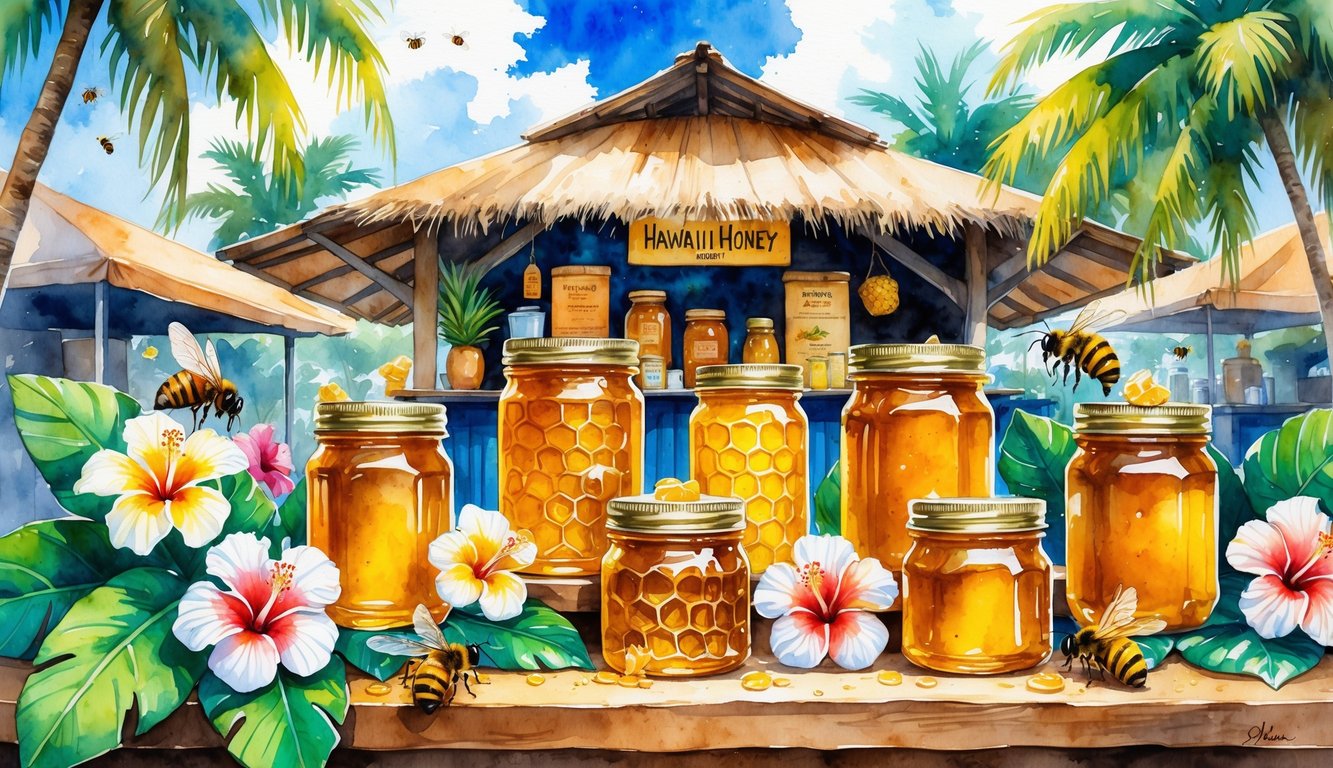
I’ve found that some of the best Hawaiian honey is easy to get if I know where to look. I like supporting local businesses and tasting honey from different parts of the Big Island.
Farmers Markets in the Big Island of Hawaii
When I want fresh honey, I often stop by farmers markets on the Big Island. Hilo Farmers Market is famous for its variety and local food stalls.
Small honey producers sell honey in jars, comb, and even honey sticks. I get to meet the producers and sometimes taste honey before buying.
Some markets, like the Kona Farmers Market and Waimea Town Market, have special booths run by local beekeepers. I can usually find raw, unfiltered honey, and learn more about how it’s made.
Farmers markets are great for special honey, like macadamia nut blossom and ohia lehua honey, which come only from Hawaii. Sellers often share how their bees thrive on native flowers.
Prices can vary, but I like knowing I’m helping small businesses in my neighborhood.
Visiting Apiaries and Beekeepers
Sometimes, I visit an apiary for a tour and honey tasting. Many Big Island apiaries, such as Big Island Honey, have tasting rooms and let me see how honey is extracted and bottled.
I enjoy learning about the history of beekeeping in Hawaii and how bees are important to local crops. Some beekeepers open up their farms for educational tours and show me their hives.
At places like Hi Honey Farm, I can try “hive-to-jar” products and walk through a bee garden. I get to ask the beekeepers questions about bee health and harvesting, and find out which flowers produce the best nectar each season.
When I buy honey directly from the apiary, I get it right from the source, often just hours or days after it’s bottled. Some apiaries sell honeycomb, pollen, and beeswax, so I can pick up extra gifts or natural skincare products during my visit.
Locally Owned Honey Shops in Hilo
In Hilo, I stop by locally owned honey shops to find jars of Hawaiian honey that I might not see in supermarkets. These shops often stock products from several nearby apiaries, which gives me a chance to compare different tastes and textures.
I sometimes find creamed honey, flavored infusions, or limited-batch runs that change with the seasons. Friendly shop owners tell me about where their honey comes from and help me pick out the best options for baking, tea, or just spreading on toast.
Some stores offer tastings and carry unique gifts like beeswax candles or honey-infused snacks. I like shopping at these stores because I’m supporting local families and getting top-quality honey at the same time.
Shops in downtown Hilo and along the coast are easy to reach. Lahaina Honey Company offers a good selection of locally produced honey and island-made gifts.
I always leave with something delicious and new to try.
Online Sources for Hawaiian Honey Products
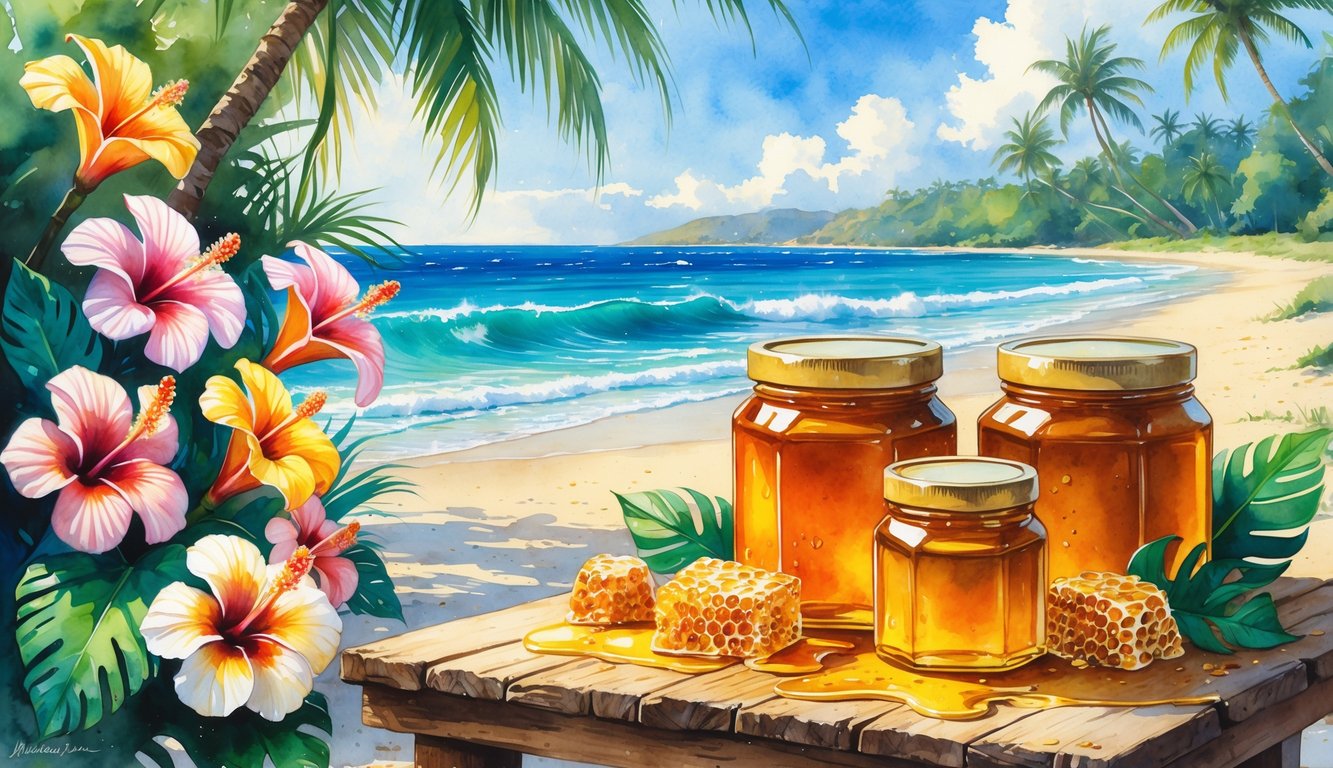
I’ve found many reliable ways to buy Hawaiian honey online. Some shops stand out for variety, while others offer special deals like free shipping.
Official Hawaiian Honey Retailers
When I shop online, I prefer buying directly from official Hawaiian honey retailers. Rare Hawaiian Honey offers products like organic Kiawe honey, lilikoi-flavored honey, and honey sets.
Their shop features cases, single jars, and gift packs. Rainbow Bees is another favorite and focuses on high-quality Hawaiian honey.
They offer honey pouches, bundles, pollen, comb honey, and beeswax. Mānoa Honey & Mead features local raw honey and infusions.
Ordering from these official shops helps me know the honey is really from Hawaii. Most retailers explain where their honey comes from, so I can learn more about each product.
Big Island Bees Online Shop
Big Island Bees is one of the largest honey producers in Hawaii. Their online shop lets me buy honey harvested right from their own hives.
They have several varietals, all produced on the Big Island, including Lehua, Macadamia, and Wilelaiki blossom honeys. When I order, I can pick from single jars, gift sets, or specialty honeys.
They also offer body care and other bee products. Each item comes with details about where it was collected and how it was produced.
The shop is easy to browse and includes tips for recipes using their honey. Big Island Bees is known for quality and a wide variety of Hawaiian honeys.
Websites Offering Free Shipping
Finding free shipping on Hawaiian honey is a big plus, especially since honey jars can be heavy. Some online shops and marketplaces now offer this for select orders.
Hawaiian Farmers Market sometimes includes free shipping on special honey bundles or larger orders. They feature curated selections of raw Hawaiian honey from trusted islands and beekeepers.
Holiday gift boxes or sampler packs often come with shipping included. I check each site for current deals or promos because free shipping may only apply when I spend a certain amount.
Shopping during holidays or local honey festivals can increase the chances of finding these deals. It pays to read the details before checking out, so I make sure I’m getting the best value and not paying extra for delivery.
Types of Hawaiian Honey Available
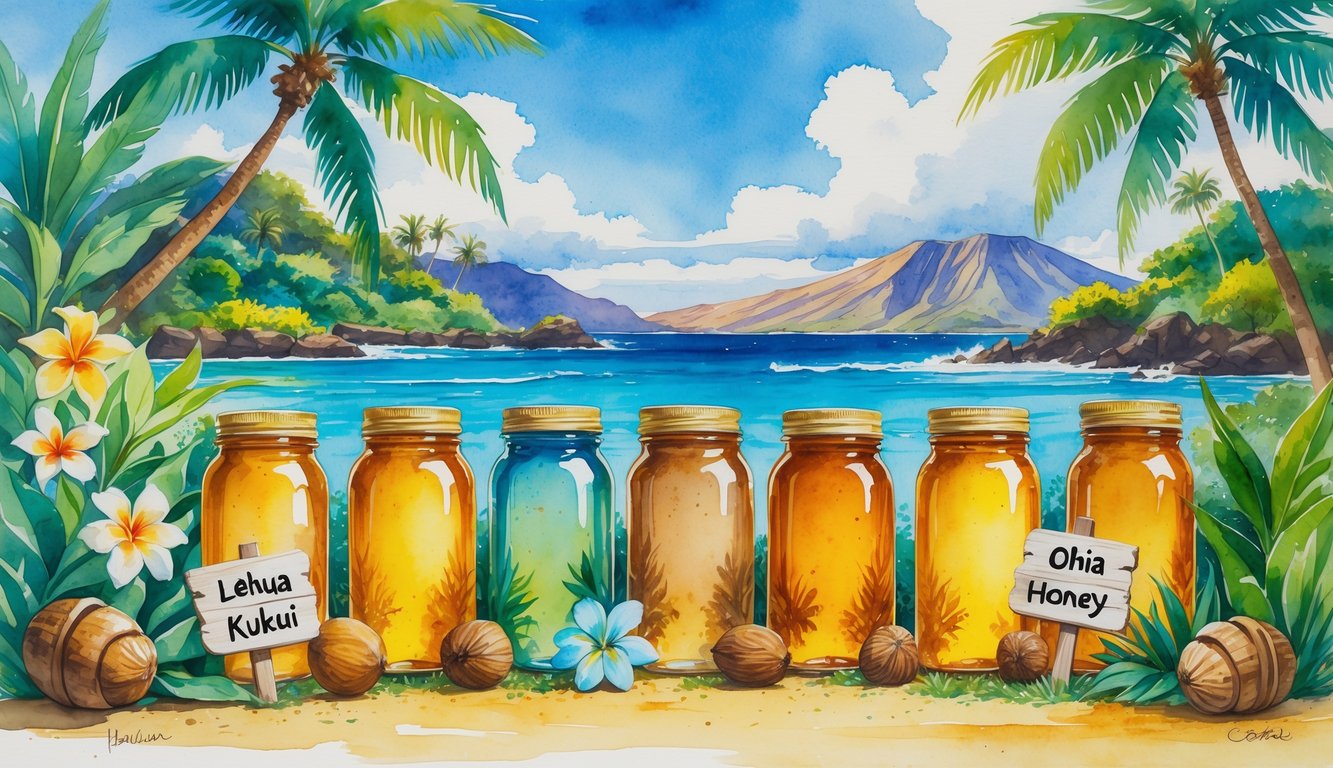
Hawaiian honey comes in several distinct types, each with its own taste and qualities. Some are made from one floral source, while others blend flavors from across the islands.
Raw Honey and Organic Honey
When I look for Hawaiian honey, I notice that many products focus on being raw or organic. Raw honey is not heated or heavily processed, so it keeps more natural enzymes, flavor, and nutrients.
Eating raw honey often gives you a richer taste and more benefits because it’s closer to how the bees made it. Organic honey is made by bees kept away from pesticides or harmful chemicals.
Farms growing organic honey must meet strict standards to be called organic. You’ll often find raw and organic honey sold by local farms and online shops.
Some options even highlight that they are unfiltered or harvested fresh. If keeping things natural is important to me, I always look for honey labeled as raw or organic, like the ones at Aloha Farms Hawaii.
Macadamia Honey and Multi-Floral Honey
One flavor that stands out in Hawaii is macadamia honey. Bees make this honey mostly by gathering nectar from macadamia nut flowers.
It has a rich, slightly nutty taste that is different from other types. I also see a lot of multi-floral honey in Hawaii.
Multi-floral honey comes from more than one type of flower. Because the islands have such a variety of plants, the taste can be complex and unique.
Multi-floral honey is often described as very fresh and full-flavored. Some brands offer both macadamia monofloral honey and award-winning blends.
Trying macadamia and multi-floral honey from places like Rainbow Bees lets me taste different sides of Hawaii’s environment.
Natural Products and Gift Set Options
Many Hawaiian producers make natural bee products besides jars of honey. I find options like honeycomb, bee pollen, and pure beeswax.
These extras work well for cooking, skincare, or snacks.
For gifts or variety, I enjoy when shops offer honey gift sets. Some sets include several types of honey, sometimes paired with honey-based treats or skin care.
These gift packs let people sample different flavors without buying large jars.
Shops such as Kailua Honey sell handcrafted honey infusions and collections. I can easily share my favorite Hawaiian flavors with friends and family this way.
Supporting Local Hawaiian Beekeepers
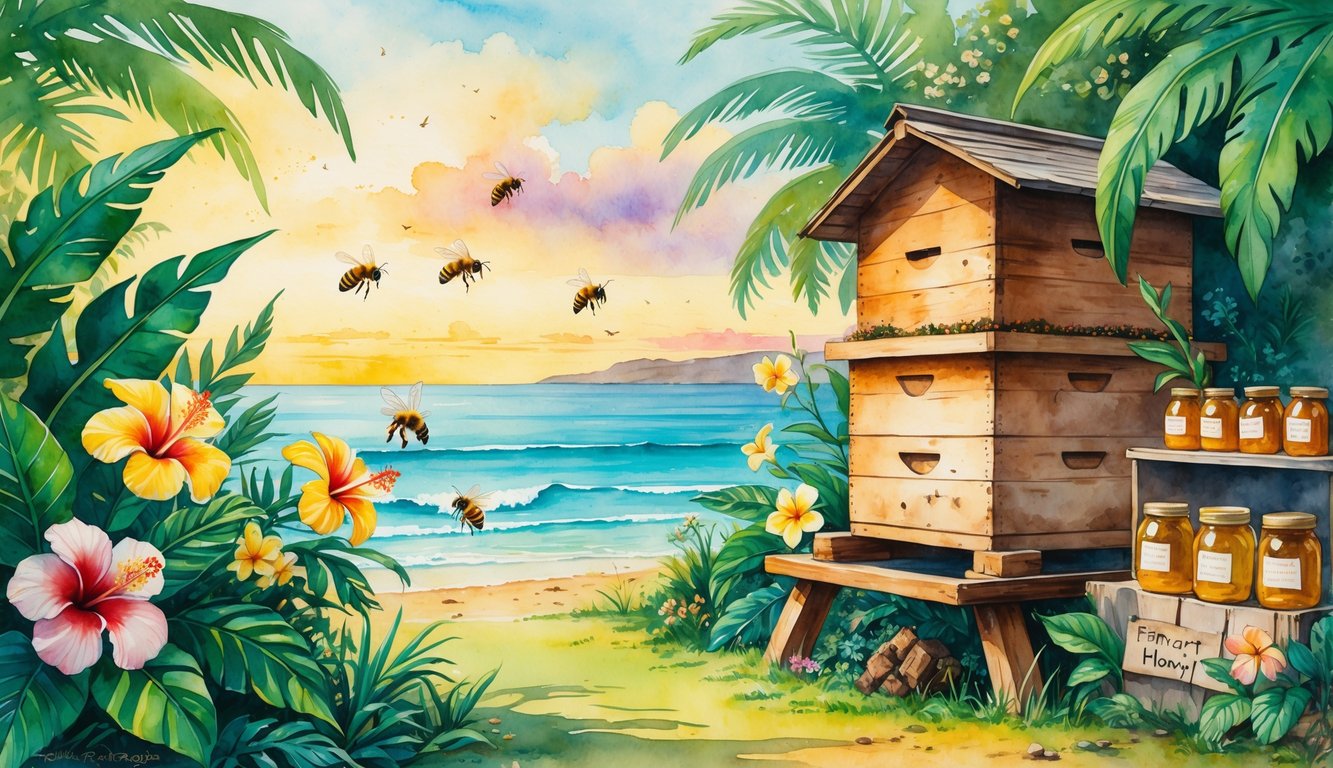
When I buy Hawaiian honey, I get more than just a sweet treat. I support local jobs and help keep unique island ecosystems healthy.
Sustainable Beekeeping Practices
People like me protect native plants and keep wild bee populations safe through sustainable beekeeping in Hawaii. Many locally owned honey producers keep their bees in clean, pesticide-free areas.
They use careful methods to avoid over-harvesting honey so the bees stay healthy and can pollinate island crops. Some farms follow organic guidelines and avoid harmful chemicals.
They also give bees plenty of natural food sources instead of just using sugar water. A few beekeepers move their hives across different Hawaiian regions to help plants like ohia or macadamia nuts get pollinated at the right time.
This careful planning helps both the bees and local farms. I can read more about these efforts at Hawaii Beekeepers’ Association, which shares tips on sustainable honey production.
Benefits of Buying Local
When I buy honey made in Hawaii, I help strengthen small businesses in my community. Locally owned honey companies provide jobs and support family farms.
They keep more money circulating in Hawaii’s economy. This means more fresh food and continued traditions.
Buying local honey often gives me fresher products with unique Hawaiian flavors, like lehua or macadamia nut. Local honey can sometimes help with mild allergy relief since it includes local pollens.
Businesses such as Hawaiian Rainbow Bees work to keep prices fair for both consumers and beekeepers.
How to Identify Authentic Hawaii Honey
To make sure I am really getting pure Hawaii honey, I check the label for the island or region where it was made.
Producers often display certification from groups like the Hawaii Beekeepers’ Association.
I avoid products with vague labels or brands that don’t list their local address.
Looking for the names of specific flowers, such as lehua blossom or macadamia, can also help.
Real Hawaiian honey usually comes raw and unfiltered, so it isn’t heavily processed.
I find trusted local brands and farms on sites like Buy Hawaiʻi Honey or Pualani Bee Farm.
These sites list options that come directly from beekeepers.




